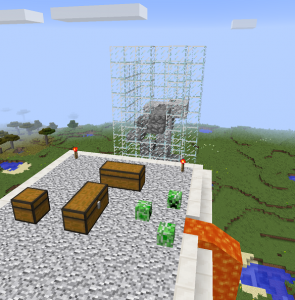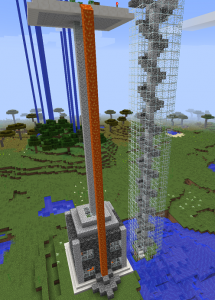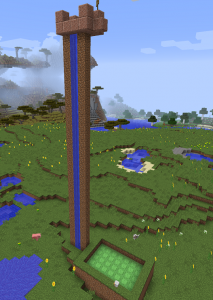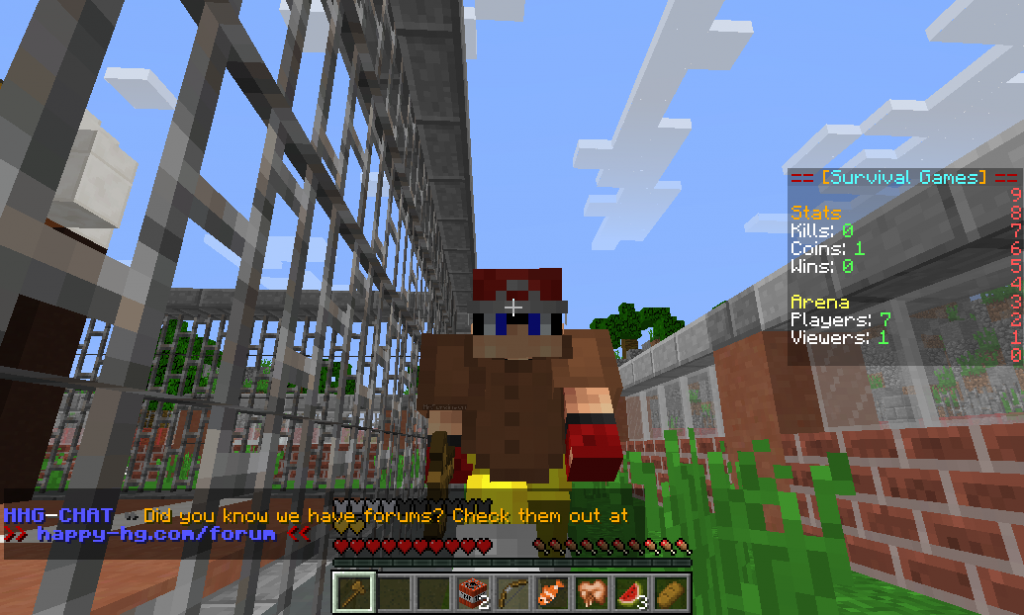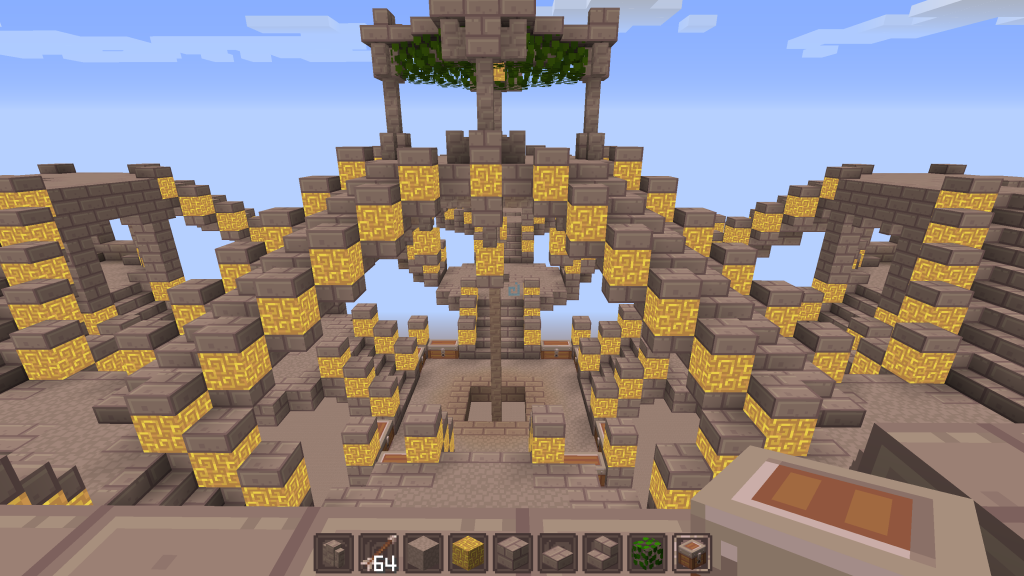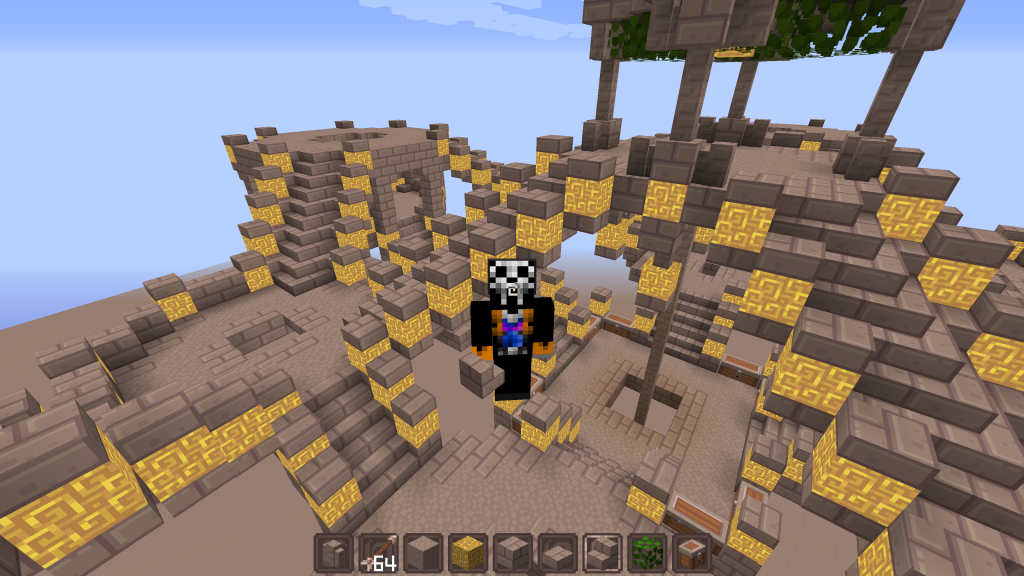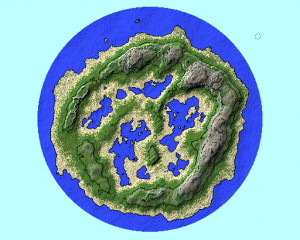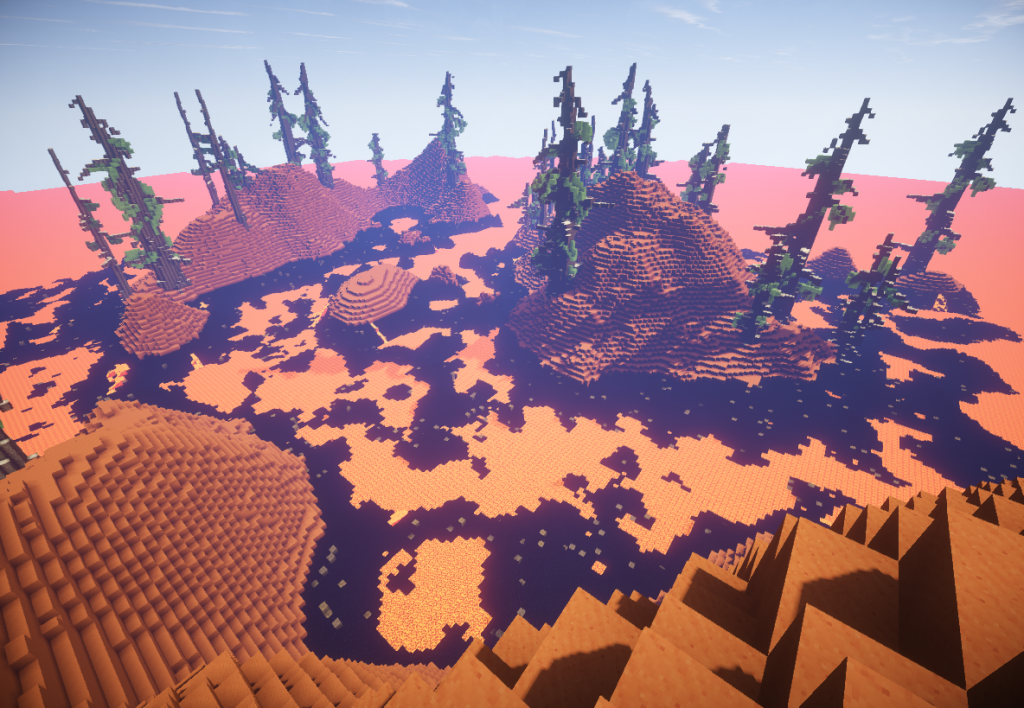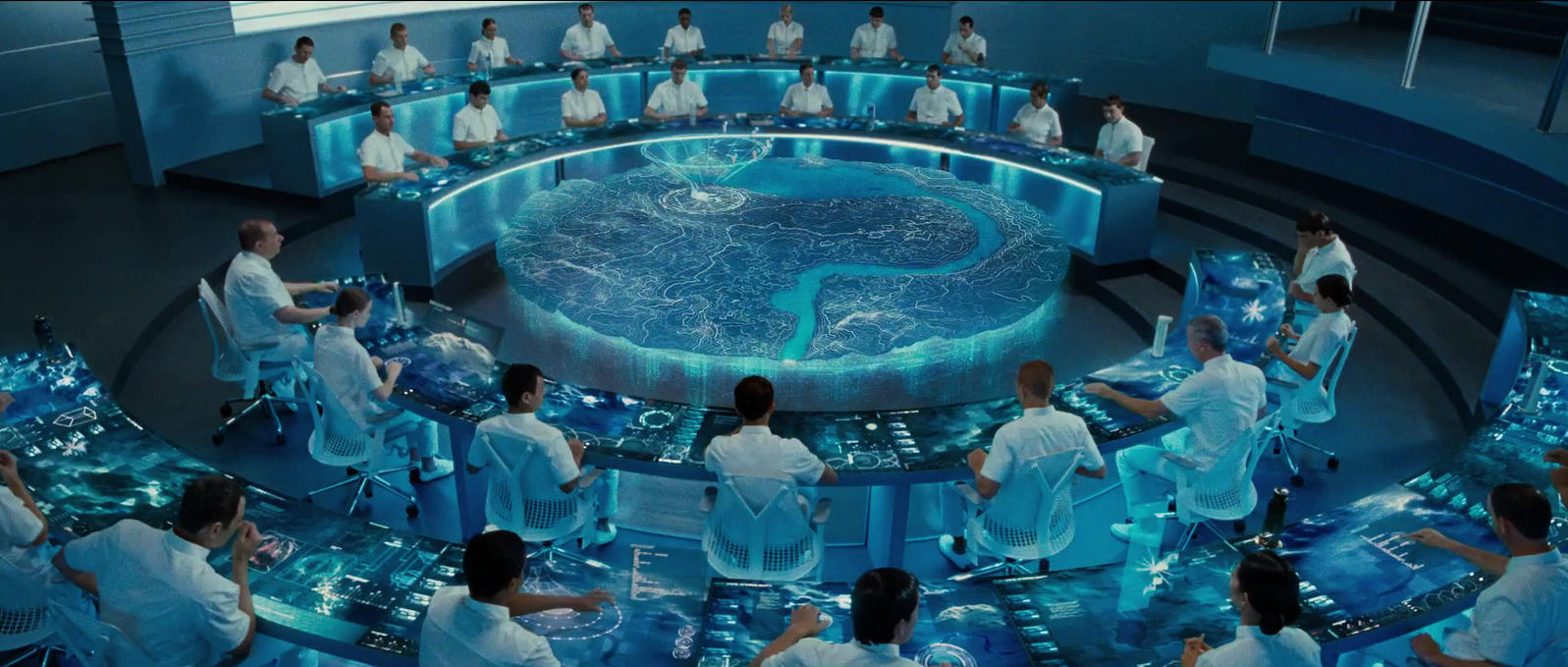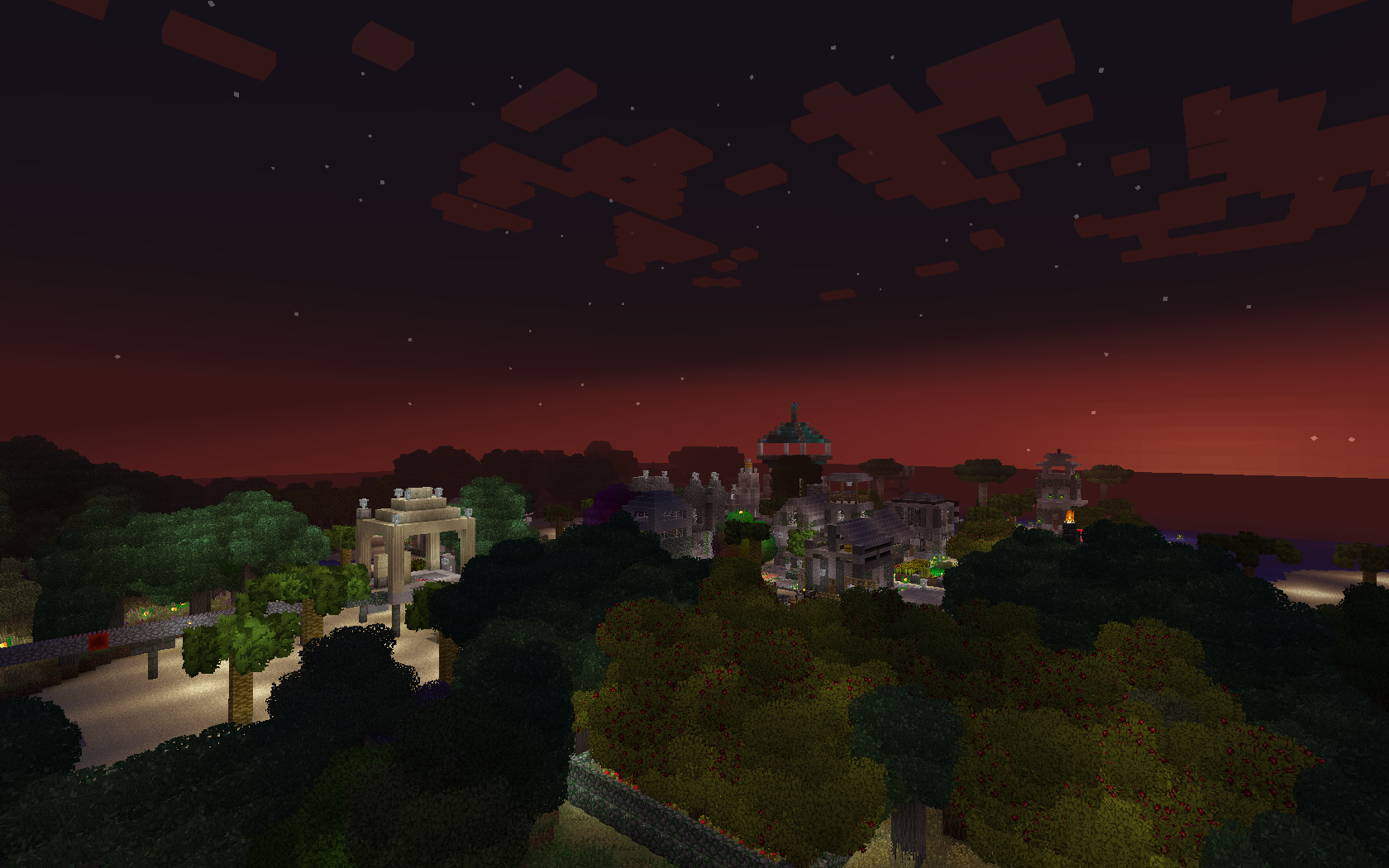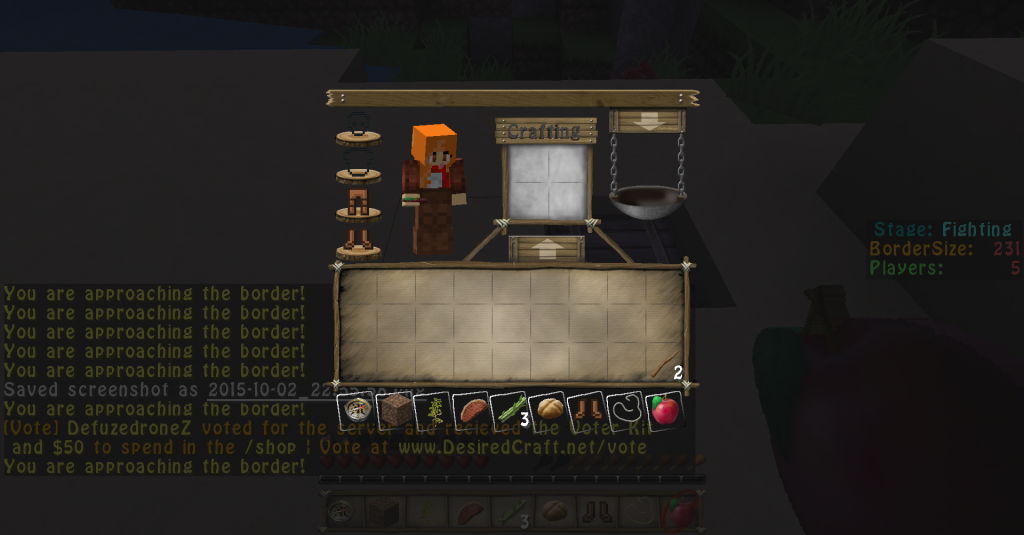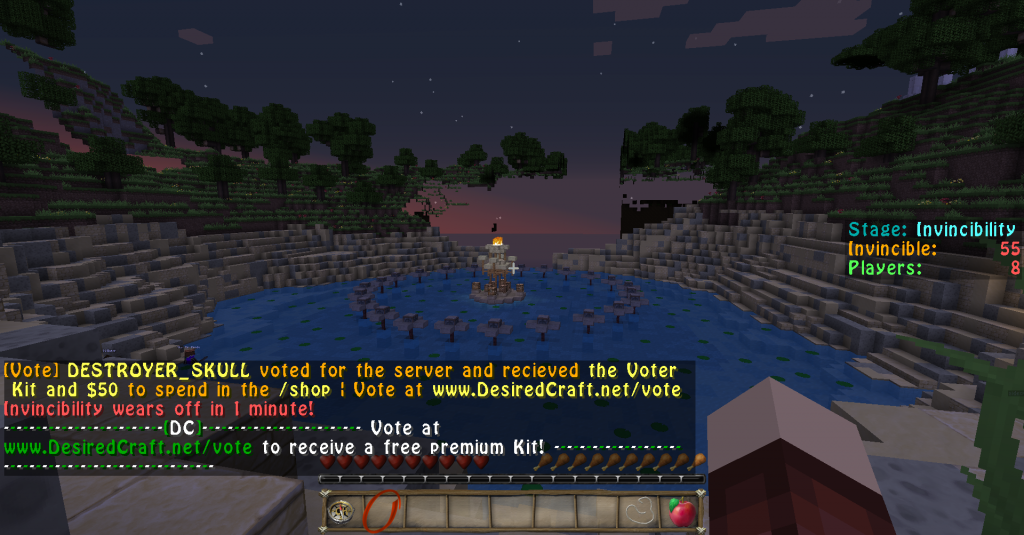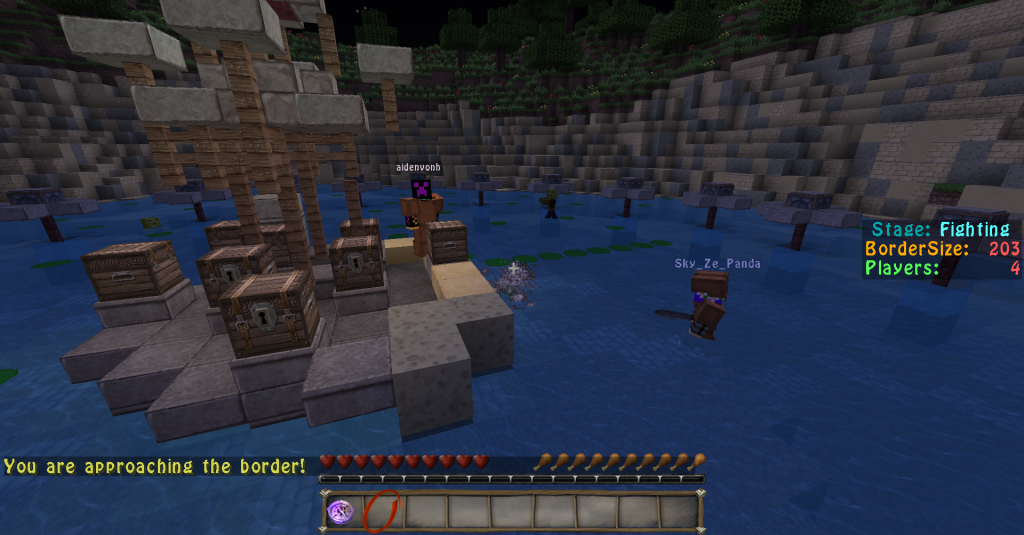The post Hunger Game Design 1 appeared first on &.
]]>For our first design, Saeed and I choose to create an elevated cornucopia with twelve towers. Participants would “spawn” in one of the twelve towers and would have the option of jumping onto the lower cornucopia platform, with chests and the possibility of death, or run down the spiraling staircase and into the ocean. From there, they can swim towards land surrounding the cornucopia.
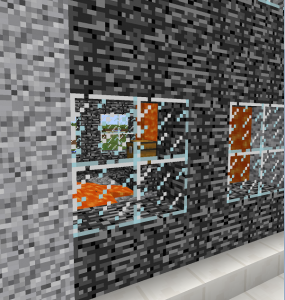
windows that allow the player to see the large chest therein when they descent using the spiral staircases
The basics of the idea are as follows:
The cornucopia and spawn points are located in the middle of the map and each corner of the map would feature a different zone such as a volcano zone and a forest zone. The cornucopia sits on top of a chamber whose door is hidden by a downfall of lava. The player needs to secure a bucket and water (found in a chest on the cornucopia platform), throw it onto the lava, make their way down to ground level and then will be able to enter the chamber and take possession of the prestigious prize. We don’t expect players to understand this puzzle right away and have thus added windows that allow the player to see the large chest therein when they descent using the spiral staircases. We understand that once the puzzle is understood, the game might become dull if played repeatedly, but at the same time, Hunger Game maps in the novels are only used once; the tributes do not know what is going to happen, or what surprises they may find. Hence, we may want to introduce a system that would not allow a player to enter a match again after 2 or 3 deaths.
The player map area is completely surrounded by glass (this will be called level 1). The player can only play within the confines of level 1 terrain. The game makers, i.e. us, have access to levers and events on the top of this terrain, henceforth named level two. Players do not have access to the second level. This allows us to view and control events going down on the map. We can spawn monsters from above and into the play area to motivate activity like in the films and books. We found that creatures could survive elevated drops except for spiders that died on impact. We tried spawning them on top of water, but the spiders still died. Finally Saeed created a slime trampoline that allowed us to spawn spiders without them dying on impact.
We can also set forests on fire to force players closer together through slots on the second level. We practiced with lava and trees grown in close proximity and found that we could control forest fires. Unfortunately, lava falls very slowly. We would need to figure out a way to set the forest on fire more quickly. Additionally, we found that we built out platforms too high, making the spiraling staircases overly long. We would need to build our platforms less high. We also found that creating an ocean in Minecraft is much harder than it looks. At the moment, our ocean looks like a right mess – we would need to spend more time studying how oceans are generated in the game.
The group meeting allowed us to view our peer’s map proposals. We found that our map may be to limiting for players in terms of re-playability. However, we do not necessarily see this as something wrong, as, like I previously stated, this would work hand and hand with the “real” Hunger Game mechanics: learn quickly, stay sharp, and don’t die, or you cannot come back. We still have a long way to go in terms of map creation and in terms of what aspects of Hunger Games we want to explore. Do we want to explore player-map interactions? Do we want to simulate a more accurate depiction of Hunger Game? How do we want to differentiate ourselves from other PVP #hungergames servers? In what ways will our maps create a relationship or dialogue with the novel’s narratives (if at all)? In the weeks to come I hope we are able to sit down together and discuss the future of our project in relation to these questions.
The post Hunger Game Design 1 appeared first on &.
]]>The post Hungercraft: A Taste-Test appeared first on &.
]]>Over the past little while I’d made the move from being simply an observer to an active participant in the savage phenomena that is Hungercraft.
It’s been a colourful experience: I’ve done a lot of running and a lot of hiding; I’ve died within seconds while trying to remember how to open my inventory because I am Very Good at this game; I’ve mistaken ducks for other players out of the corner of my eye; I’ve killed exactly zero players, aside from one time when I lead a pursuer into an abyss, to both of our untimely demises; I’ve both gone solo and teamed up with other tributes; I’ve gotten a closer look at the behaviours of players who run around an arena – dressed in the likeness of everyone from Sephiroth to Steven Universe – trying to kill each other. It’s all been pretty fantastic.
I tried to pay particular attention to how the arena was directing my choices and actions – I wasn’t particularly interested in winning (I say purely to make myself feel better), but of absorbing and embroiling myself in the various narrative possibilities of the arena. The process itself was absolutely fascinating. I put on my ‘Researcher’ cap and set to work.
The match was a well-oiled process that took between 12 and 24 players and allowed them each a vote for the type of arena that would host the match. These ranged from cyberpunk-esque cities to tropical islands to palatial temples to thus-far unseen mysteries as a result of the democratic process at work – and the clear favoring of certain arenas over the rest. Much of the usual Hunger Games imagery was present: a depiction of Katniss’ ‘Mockingjay’ pin was an ever-present fixture in the sky above the lobby, players were referred to as ‘Tributes’, and each map had a Cornucopia in some form or another. Just as in the narratives of the film and book, the most vicious round of killing occurred at the beginning of a given match, as everyone ran for the chests in the cornucopia. By the time most of the tributes had been slaughtered, survivors were teleported into a much smaller arena for a death match, and things were usually settled within seconds.
The entire thing seemed to run more-or-less autonomously. At no point was there any human intervention, or any need for human intervention. There were consistently over a hundred players online at any given time, and it was never hard to amass a group for a round of good ol’ competitive murder. As soon as you were killed, you could head back to the lobby to start another game, ad infinitum.
In Suzanne Collins’ fictional world of Panem, each Hunger Game was a monumental affair, requiring human labor and effort to actualize. This is to say nothing of its prominence as the biggest annual cultural event for all of Panem’s citizens, making it a thing to be anticipated, dreaded, excited for, horrified of. In short, for good or for ill, a Hunger Game was a pretty Big Deal. In Minecraft, we get the fast food version of that: it’s quick, it requires minimal effort, it involves as little human intervention as possible, it offers only fleeting satisfaction, it ends just as you’re starting to enjoy it – but is always there, open for you 24 hours a day, to indulge in – and you feel just a little greasy afterwards.
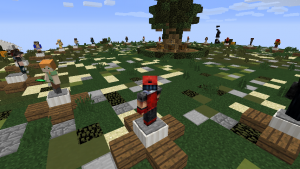
Sure “Survival Arena” is great and all, but how will I ever know the majesty of “Butterland” if no one ever votes for it?
A small step towards regaining some of the pomp associated with the Hunger Games of Panem would be to, as Marie-Christine has suggested, reintroduce humans as overseers and manipulators. As such, we have geared our research towards the reintroduction of live events as a means of changing up the game – an element that falls somewhere in between player choices guided by explicit rules and player choices guided by level design. To borrow my colleague’s example, burning down a forest to flush players out of a certain area both remains true to the book and adds an element of chance (beyond whether your opponent is going to look like a deformed Homer Simpson or a deformed Pikachu) that hinges on the most chaotic variable available: the human whim!
The inclusion of human intervention calls back to a point I made earlier, regarding the strictly man vs. man conflict present in current Hungercraft games. In this case, however, if man is manipulating the natural surroundings in order to create obstacles for other players, can the conflict truly be classified as man vs. nature?
In addition to pyromania (and the like), I’d like to explore the possibility of hosting events that would lure out players of their own will – such as the feasts featured in the books, which promised food and supplies for the few tributes brave enough to enter into a common space with each other. From a research perspective, I think this will allow for a new depth of insight regarding player behavior – both for the tributes as well as for the game-makers, as well as make strides towards making Hungercraft a more social, ceremonious experience akin to Collins’ vision as described in her books. Only without raffling off the freedom of children.
The post Hungercraft: A Taste-Test appeared first on &.
]]>The post Crafting Dynamics appeared first on &.
]]>Weeknote: While attempting to create some original dynamics through the influence of the environment, I realized that I’ve never been too much of a terraformer. I thus switched my focus from map to structure.
From Arena: My initial idea was to build from scratch an arcade-inspired arena. I chose to make a structure for bow-fights, being both a core element of the selected genre and a forte of any Minecraft PvP. I therefore played a lot on heights, covers and open chest zones. The original idea would have been to separate loots, excentred bows and chests full of arrows in the middle uncovered space. That way, I expected first games to be played very individually, with fast victories from rushing players; and to observe a tendency in later games of teaming/pairing up out of necessity in front of the dilemma bow/arrow.
Nevertheless, while being mini-game in itself, the prototype turns out to be incomplete as a sole arena.
To Spawn: Then, wondering about how to include the previously discussed constraints of Hunger Games (such as actual hunger, resources or even a lava pit…), I came to think that the arena could be much more interesting as an in-map structure, or even a spawn! From the separation (spawn/map) of interdependent resources (arrows in/ bows+food out) might very well arise teams and bandwagons for the defense/attack of a spawn bound to become a citadel. Basically pushing incentives of cooperation through incentives of polarization, a hunger games siege.
Implementation: Crucial would become the separation of resource between in and out, the question is to be weighed with other mechanisms already discussed. Equally important becomes the number of potential entries and their design (defense friendly or not).
The post Crafting Dynamics appeared first on &.
]]>The post Ravenous Recreation appeared first on &.
]]>We have been musing over what exactly constitutes Hunger Games in Minecraft, especially since the community already has an idea of what it is and it diverges significantly from the books, movies, and what many of us want our subjects to experience. Setting theory aside for now, I have started prototyping maps for my own gameplay styles and length, rules, item availability, and general layout and theme, hoping to perhaps shed some light on the issue of definition through a hands-on approach.
As it turns out, map making on a small scale in Minecraft, especially if you don’t care too much about proper geography and erosion lines, is hilariously simple and can be learned and applied quickly within an afternoon. Massive custom trees in particular appealed to me, both being a good location for base-style warfare, and being susceptible to fire. Large caverns also became a small obsession, but was abandoned in favour for smaller caves that are open to the sky. While I had found how to make it so all surfaces had a maximum depth of two blocks, it quickly opened the door to permanent hiding underground, and despite my strong desire to have such tactics be available, I did not want it to be so easily accessible that it automatically became the preferred play style. I wanted, and still want, a map that encourages divergent play styles and rewards quick thinking and reflexes as well as tactical play.
In the end, it boiled down to two maps with distinct flavours, which my reluctant “testers” nicknamed “Eden” and “Hell”. Both were small and island-like, with a walking time from one edge to the opposite of about 2 minutes when discounting mountains. From a high point and the default draw distance, it is possible to see the entire map, and those moving upon it, enticing players to fight, destroy bases that others would try to create, or hide to the best of their abilities.
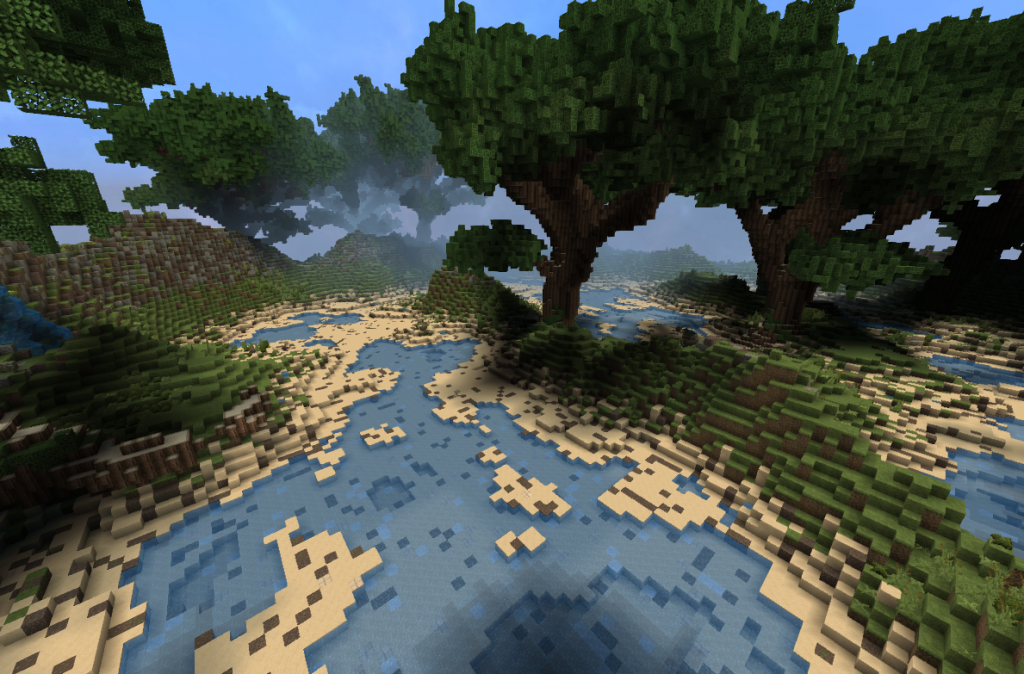
“Eden”
Eden was the first prototype that I worked on, and as the nickname implies, was a small garden-like place with massive trees. Working on the concept of scarcity, Eden had plenty of food sources, but almost no materials of higher “class”. Consequently, weapons other than of stone or wood were incredibly rare, and armour was nearly non-existent. With exactly two diamonds hidden at almost opposite ends of the maps, a diamond sword was a sight to behold, and almost guaranteed victory to the wielder. “Easy” sources of food, that is, mobs and their ilk, were disabled because it granted too much of an edge to those that chose to pursue the warrior’s path.
Pros:
- Large trees became make-shift bases. Bows and arrows, fishing rods, and flint & steel were used in a variety ways to remove “campers” from trees.
- Diverse game styles were common. Some would rush for weapons, but consequently had trouble being fed if they failed to kill anyone. Farmers would sometimes trade food in exchange for protection or to be spared. Alternation upon and modification of these roles were common.
- Kills were almost entirely player-choice, and no one felt “cheated” when an opponent starved or fell to their death.
- Alliances (and betrayals) were common and entertaining for both viewers and participants.
Cons:
- Apart from being explicitly stated in the rules and a requirement to win, there was almost no incentive to kill other players.
- Hiding reached almost epidemic levels. Players realised hidden farms were the easiest way to win rather quickly and gameplay became a strange version of cat and mouse, with the mice sometimes becoming cats out of boredom, and cats becoming mice out of necessity.
- A large number of players was required for the map to be interesting, and when only a few players remained, ending the match was a grueling task that was entertaining for absolutely no one.
- Playing time was long, clocking in at roughly a few hours.
The second map, nicknamed “Hell”, looked like the visual opposite of Eden, but was almost the same topographically. A small map with large trees with grass replaced with red sand, sand replaced with obsidian, and water replaced with lava. In addition, the scarcity of materials and food was switched. Weapons were abundant, as were the materials to make them, but food was incredibly scarce. Forget iron, you were far more likely to be brutally murdered for an apple. Dirt was the gold standard and essential for survival, as was combat. Constant fighting to get food was the norm, and it looked a whole lot more like what the Hunger Games depicts in fiction.
Pros:
- Constant fighting, and no need for artificial incentives.
- Massive satisfaction for winning due to difficulty of survival.
- Hiding for a long time was both difficult in the bare landscape and often suicidal. Only the best could pull it off, and many chose not to even attempt it.
- Playing time was short, clocking in on average at almost an hour, depending on if the game went on until the very end or when equilibrium between players was reached.
Cons:
- Many, many, players died of simple misclicks due to the omnipresent lava, and reduced the sense of satisfaction of some winners.
- Players with little experience in Minecraft or who were not dextrous enough to navigate lava fields had no chance of winning.
- Some players would jump into lava to spite their aggressors by destroying all their possessions.
- Once again, end game dragged on for a very long time.
To summarise, it appears that simple Minecraft worlds and the variation of scarcity of certain materials on its own is enough to create a Hunger Games environment, but which ones were artificially limited changed player behaviour in a myriad of ways. It also caused some moments of reflection, wondering if I prefered the incentive for diplomacy and trade over the incentive for warfare, and whether player satisfaction should be central to the design of the map.
I continue to explore avenues of changing the gameplay; increasing levels of water or lava as time progresses, chests of goodies in certain locations, the addition of a Game Master or Sponsors, and the possibility of a tracking system to make it harder to hide or not and their subsequent impact on emergent play and balance. Nonetheless, this hands-on exploration of environmental factors’ effect on player behaviour was illuminating and I look forward to where it may lead in the final design.
The post Ravenous Recreation appeared first on &.
]]>The post Place for a “real” Hunger Games server? appeared first on &.
]]>This week I plan to share my ideas for how to create a more authentic portrayal of the novel “Hunger Games” in Minecraft.
What seems to be the crucial element in the realization of a “Hunger Games” server is the player-versus-player arena. Why do I say this is crucial? Every #Hungergames servers we have tried has revolved around players fighting other players in order to survive and “win”. However, that appears to be the only thing that is like “Hunger Games”. I believe this is boring and is just an excuse to call everything #Hungergames when in fact, it is only PVP. So what could WE do differently?
For starters, we could have our own “Head Gamemaker”. What, or who is this person? In the book it is Seneca Crane, and then Plutarch Heavensbee. As “Head Gamemaker” they create the arena where the participants from the different districts will compete. Once the games begin, they control the environment with their team of controllers that can cause forests to combust instantaneously, creatures to magically appear or any other such activity. By doing these things, the Gamemaker insures that the different “tributes” will end up close to each other and thus fight – creating a “glorious show” for the residences of the Capital (or a depressing and distressing one for the districts watching their children die).
So what could we do? We are all technically “Gamemakers” in that we will be creating the arena. My suggestion is that we have live events. Of course, we could not always hold live events as we do have lives other scholarly things to do–but the idea remains that we could host events. First, we would need to make sure that all “gamemakers” are in some sort of “creative mode” and perhaps invisible to players in “survival” mode. Second, we would create a sort of ceiling around our map — this ceiling would be made out of glass. We could see everything happening on the field from our high vantage point. Third, we would have levers or other devices we could switch on and off to: pour lava from the sky and burn the forest, release mobs, et etc. This would allow us to create a more realistic Hunger Game competition like in the “Hunger Game” novel. Additionally, each event a different member could rule as “Head Gamemaker” and make the crucial decisions.
But why should we only focus on this one aspect of the novel?
While speaking with Nic on this subject, I told him about one another though I had come up with and that we then expanded together.
The bigger Minecraft servers usually have multiple “lobbies” to hold many players: players might be in these lobbies to mingle, to choose a game, or are waiting for a game to end so that they may start. Why not have our lobbies named after the 12 districts?
When a player would log into our server they would be assigned to a district. From there they wait for their turn to be selected by the computer. When it is their turn, the chat would post a message, example:
Marie has been selected to represent district ____
At this point, another player could then respond with something like:
//I volunteer as tribute! OR //VAT
of course, then Marie would have the choice to begin her game or to allow the other player to volunteer.
Alright, so players can play around in different lobbies while they wait for the game to start, big whoop, what else?
Well, some players could also be placed within The Capital and be given thousands of diamonds. These players could then play as invisible players within the actual arena and dispense presents to their favorite tributes–like in the novel. The “tributes” would be teleported to a room where they could talk with the players in the Capital lobby and barter for help.
We could also give players access to different things depending on their lobby; swords, bows, fire, wood, etc.
Perhaps we could have a point system and once a player has won enough credits they can “pay” to be moved to the capital.
Another idea was that any player who actually died in the arena would die in the game: they would no longer be able to fight in the arena — perhaps they could be “reborn” as members of the capital? Able to visualize the events and help players out or spring traps, but essentially invisible within the arena. Or perhaps we could give each player 5 lives to play within the arena and then they are “dead” ?
These ideas had us asking new questions: would these new rules really create a true depiction of Hunger Games? would players actually feel the class distinction and the terror at losing? Would a war break out between the districts like in the film? Would the capital want to quealm it? What would we have to give players in The Capital to have them maintain other players and keep ruling? How many players would jump the boundaries or play and begin acting as security? What kind of game would this become? Would we moderate it or just allow player to rule it as they wished? Would we even have enough players for this to happen?
I am unsure. While this might create a more realistic portrayal of the books, it seems like a lot of time and energy. Perhaps all players want is to kill other players without consequences. To know that if they die they can play the game again. Perhaps they don’t care that the game is not really Hunger Games but just a small aspect of the book, or even just a ploy to entice more players into PVP servers. This idea would require a lot of cooperation to build, and then a lot of players to fill. We might want to look at servers such as Potterworld (http://www.potterworldmc.com/), a “Harry Potter” Minecraft server that has a staff of over 100 unpaid players that take on the roles of prefects, professors, scripters etc. As well as the hundreds of players that play as muggles and students. This server is interesting in that players are essentially playing at being students at Hogwarts: they must attend classes, do homework and pass exams in order to pass each grade and then graduate. Once they graduate, they can apply to become professors, aurores, deatheaters, or any other Harry Potter role. The fans maintain and keep this server alive — it is their investment and interest in the franchise that allows this server to function as it was intended. Without the fans, the server would slowly disappear.
If we were to create a “real” Hunger Games map, including the different districts, the class inequality, et ect, could we achieve what Potterworld achieved? Or would chaos reign right away as players decided to attack the Capital right away? Would we even obtain enough players to make this work ?
Perhaps for now, it is but a dream. However, I do believe that we should start by creating a way to control events in the arena, become Gamemasters and thus create “live events”. What think you?
The post Place for a “real” Hunger Games server? appeared first on &.
]]>The post Breaking the Mold appeared first on &.
]]>The way Hunger Games is used under the general player versus player game mode of Minecraft is pretty basic as the players themselves do not really concerns themselves with anything aside from winning the match. They are more concerned with stratagems, map layout, chest locations and any advantage they can get to win, anything else is pretty much tossed out the window, as a result most maps stay within a general theme or style. In response servers offer incentives for players to differentiate themselves from other servers, it is usually a point system or rewards system to keep the players interested as well as offering other Minecraft game modes. In the end however, the game mode or style remains the same so the content and progression of the game does not really change. So the challenge now is to create different styles of game play but with still keeping the staples of Hunger Games. (even though it’s just the cornucopia, designated tributes, etc..) I have thought of a couple ideas, some that were already mentioned, but I have chosen three ideas that seem the most striking for changing up the normal formula.
The first would be the normal Hunger Games mode while adding aspects of complete the monument CTM (another Minecraft game mode) as an alternate form of winning the game. The main goal would be finding a specific piece of wool hidden somewhere on the map and placing it on a red stone setup, placed either at the cornucopia or elsewhere, this will trigger something that proclaims the winner. This is a simple change but an important one as we can change the up the way to acquire the wool either by adding a puzzle element, creating a game element to force the players to cooperate with each other or even forcing them to make a sacrifice to get to the wool. This also allows to see how different players will react to the game, will they follow normal conventions to solve to puzzle or wait until someone else gets the wool just to engage in combat to take it from them. We will be able to view different thought processes to win. This would work pretty well as there many kinds of puzzles that can be used.
The second would be placing all the players in random locations inside a huge arena or tower structure, the goal would be getting from their initial location to the center where the cornucopia will be. They will then fight in standard pvp to decide a winner, the catch is that instead of fighting each other during the flow of the game like the norm, the structure will be swarming with hazards such as traps and a copious amount of mobs, this would be more a chaotic, hardcore mode and force the player to decide how they will play, do they take a slower pace avoiding the mobs and traps or do they speed through to get to the center. An interesting point with this is that mobs will be targeting the players the see so if the players decide not to kill the mobs, they will eventually follow them to the center where the players will converge.
The third would be a parkour style map using the random location from the second idea but they will be in a linear mountain area with varying levels of height and the only weapon available to them will be an infinity bow. The goal would be to get to top where the cornucopia will be, the combat aspect here will be to snipe players either from above or below so they will need to chose when and where they attack other players. This might be a little clunky in execution as I am pretty sure most will focus on getting to the top first then go in combat then but it will be interesting to see which style players chose.
These are pretty simple ideas but can be effective if implemented properly.
The post Breaking the Mold appeared first on &.
]]>The post The #HungerGames Function appeared first on &.
]]>Hunger.
Games.
A game about survival for food. A game of high consequences. In 2008, Suzanne Collins released a book titled “Hunger Games” that followed a young adult female protagonist who volunteers to take her sister’s place in a mandatory death match enforced by “the capital”, the Elite society that controls the fictional world of Panem.
So what does it mean to transpose this narrative into a sandbox game such as Minecraft? Can it even be called “Hunger Games”?
The questions we must ask before we begin our construction of a quote-on-quote “Hunger Games” arena are as follows:
What is Hunger Games? What makes Hunger Games, Hunger Games? Is it the narrative, the characters, the atmosphere, the environments? Can we simply reduce it to a Player-versus-player all out death match? How can we recreate the true essence of “Hunger Games” within Minecraft—is it even possible?
I found that often the hashtag “Hunger Games” is included in conjunction with multiple others. This use of Tags lures Hunger Games fan into joining a server that promises them the “Hunger Games” experience. The use of “Hunger Games” encourages fans to flock to the server. Could these servers only be “survival” games which have existed for a long time but are now under the guise of “Hunger games” as a means to encourage more players to join?
Commenting on my ideas on “Hunger Games” as a hashtag, Nic Watson says;
“Interesting how some of the graphic banners on that list show a subset of tags that doesn’t include ‘Hunger Games’, but ‘Hunger Games’ is in the text tags. Like they want to make it show up in HG searches but not actually promise HG. Maybe we should look at what tags are collocated with HG tags. Perhaps that could go under ‘variants’”
The “Hunger Games” games are usually included with various other mini games on one server including various PVP arenas, and Sky Block.
These are example of PVP/Hunger Game-like servers found under the tag “hunger games”:
* Play.mc-lengends.com
* Mcsimplegaming.com
* Mc.hypixel.net
* http://www.ubermc.net/minecraft-the-walls/
However, this last server is a little different from the other PVP servers above and specifies team work in order to win:
“Minecraft The Walls is a very unique server type. 4 teams divided by a walls that keep peace for the first 15 minutes of the game. During this first 15 minutes all the players on each team are given a specific class that allows them to help their team in different ways. For instance the alchemist can create potions for their team for when the walls drop. or the blacksmith that can forge weapons and armor using their anvil. Below each team spawn there are mines to be explored and resources to be exploited. Team work is crucial to winning this game as each player has a unique role. The last team to survive after the walls drop, wins the game” (The Walls).
Names and titles take on a life of their own online, both explaining the context and enticing players. But what can we say about these games that may not really be “Hunger Games” portrayals, but just PVP games using the hashtag Hungergames?
These servers are mainly focusing on the battle arena, the all-out district war (The annual Hunger Game) while overlooking everything else about the novel. In this way, what makes them any different from PVP?
In my graduate class we read sections from Michel Foucault. “What is an Author?” brings up a valid argument and question about the way players are using the key words Hungergames.
Consider this: are we, and everyone else who tags their Minecraft server, using the “author function” as a way to gain credibility and legitimization? What are we promising when we assign the hashtag #Hungergames to our game servers?
Foucault explains that “such a name [the author’s name] permits one to group together a certain number of texts, define them, differentiate them from and contrast them to others […] establish a relationship among the texts” (227).
When talking about transmedia narratives, Game scholar Henry Jenkins explains that “Audience familiarity with this basic plot structure [read: knowledge of the narrative] allows script writers to skip over transitional or expository sequences, throwing us directly into the heart of the action” (Jenkins 120). While franchises create Transmedia narratives, Minecraft can work as a form of fan generated transmedia narrative that allows players to interact with aspects of the media they normally would not have access to. However, most of these #Hungergames servers reduce the narrative to a single moment: the arena battles—we are literally thrown into the “heart of the action”, however, are we trivializing the rest of the novel that looks into inequality, poverty, capitalism, et ect? Without a deeper understanding of the consequences (are there any consequences in an online game?) of the “Hunger Games” as portrayed in Collin’s book, can we actually be anything more than a PVP using a hashtag as a function to obtain and entice players?
What are we doing to Suzanne Collin’s “Hunger Games” novel by thus tagging these PVP servers? What can we do to create a more authentic server? Is it even possible to create a server worthy of the term “Hunger Games”?
In my next post I will look at a few ways we could construct our server with these questions in mind.
Work cited
Foucault, Michel. “What is an Author”.
Jenkins, Henry. “Convergence Culture : Where Old and New Media Collide”. New York: New York University Press, 2006.
The post The #HungerGames Function appeared first on &.
]]>The post Crafting Autonomy in Minecraft appeared first on &.
]]>Without having to probe very deeply into what it offers as a game, Minecraft can offer an interesting opportunity to experiment with the concept of autonomy. I’ve written a little bit before about individual realization during discussions on concepts such as Maslow’s hierarchy in Minecraft before. On top of self-realization, the game offers interesting insight into such widespread narrative concepts as “the self-made man”, and other concepts related to autonomy and how the concept is positioned against socialization.
As the current Hunger Games project evolves, many of us are primarily interested in seeing what kind of behaviours will be created by the arenas we design. Many of our conversations, at this point in the project, center on whether or not the arena we’ll create will promote players to work together in teams or strike out on their own.
Autonomy in the Aristotelian Sense
Autonomy is a contentious topic to begin with. To start, I am working with the – admittedly limited – definition Aristotle put forth in Ethics:
[…] in this sort of model of autonomy, what defines an action as autonomous is seen as its point of origin; it must have an ‘immaculate conception’, as it were, from within the self. (Grimshaw 90)
Aristotle’s vision of autonomy was based on the principles rationality and self-sufficiently, and renounced any sort of dependency on others. This fits in well with the initial vision of Minecraft, where a player emerges anew into an Eden (or hellscape, depending on the biome) and has to rely on scrounging for materials to survive and eventually thrive.
I start with autonomy as a framework to approach this Hunger Games in Minecraft project because I’m fundamentally interested in player motivation – I’m interested in uncovering some of the reasonings that govern what in the education (and sometimes gamification) business is called intrinsic motivation.
Perhaps no single phenomenon reflects the positive potential of human nature as much as intrinsic motivation, the inherent tendency to seek out novelty and challenges, to extend and exercise one’s capacities, to explore, and to learn. (Ryan M. Ryan and Edward L. Deci 70)
I want to know why players play games the way they play them. Intrinsic motivation is defined as performing an action because one enjoys the activity itself. It seems to make sense that desire is related to intrinsic motivation – we do what we do because we want to do it.
So why do we want to do the things we want to do in a (Hunger Games) Minecraft game?
Autonomy versus Socialization/Socializing
One of the first issues encountered with the Aristotelian ideal of autonomy is that as a theory it doesn’t translate well into practice. In life, it is impossible to be born, survive infancy, grow up, and live as an adult in a vacuum. Even our most private, inner selves are shaped by the relationships that surround us. Even a person’s autonomy has to be carefully developed during the socialization in their childhood.
Autonomy and socialization/socializing can be imagined to be on different ends of a spectrum. Without neglecting the importance of social bonds, we can hazard a guess to say that even acts done for the sake of social coherence are autonomous acts. Not every action that is influenced by external or social forces is automatically coercive.
Given the right circumstances, a tension can emerge in examining socializing versus autonomy: between what we are supposed to want to do and what we actually want to do. Without delving too deeply into the land of psychology and philosophy (and the murky depths between) let’s bring this back to Minecraft.
Why Do We Do What We Do In (Hunger Games) Minecraft
Unlike vanilla single-player Minecraft, multiplayer Minecraft brings out a very tangible opportunity for cooperation and socializing. Hunger Games Minecraft adds a certain gladiator/bataille royale wrench into the mix.
(Sidenote: In my experience many multiplayer Minecraft servers tend to end up looking like warzones, even if the option of peace and cooperation is ostensibly available. One of my favourite articles from 2012 is actually a post on PC Gamer which describes a truly devastating resource war on an experimental Minecraft server. It turns out that the experiment never took place and that the story was crafted as a hoax – but resource-depletion and all-out-aggressive multiplayer shenanigans are actually pretty common on multiplayer servers, a fact that was recorded by the minDcraft project at TAG in early 2015.)
By design, however, the Hunger Games from the novel/movie series are made to emphasize a specific kind of socializing and autonomy – the kind where one’s allies are also explicitly one’s adversaries. It creates an interesting reversal of the definition of autonomy seen above (which is usually understood to be born from socialization). In the Hunger Games, any sort of socializing is done with a shared understanding that it is done only to enhance the individual’s chances of staying alive and winning the game. Every player participating in the Hunger Games understands to forego the niceties common to most social groupings: the goal is to win, by any means necessary.
What if, however, winning the Hunger Games on a Minecraft server is not one’s intrinsic desire? What if winning the Games is not enough for some players? Unlike the book series, the players aren’t actually going to die, only their Minecraft avatars perish and they lose the game.
We are designing this Minecraft arena for players who are going to be playing because it is a class assignment. I am assuming that they may not be intrinsically motivated to play Minecraft in general, though it is possible some may be. It’s going to be interesting to see how these players react to an arena on top of reacting to Minecraft in general.
I am very interested in seeing how players who are not battle-hardened Minecraft players react to the challenges of the game and our arena. I am also interested in seeing how players react to arena traps or challenges that have been crafted to either foster competition or cooperation.
The arena
If I’ve learned anything from playing way too much Minecraft, it’s that social environments are usually more important than the actual physical layout of the land. We’re spending a lot of time thinking about traps, layouts, underwater or lava-sunken terrains: while these have an undisputed effect on the atmosphere and gameplay, I’m wondering as to their efficacy in influencing player’s responses with regards to their motivations.
Without the usual resource-gathering/hoarding motivations that are usual to Minecraft (not to mention not wanting to get blown up by creepers), it’s going to be interesting to see how players find motivation to play the game. But I suppose the motivation of not getting shoved into lava or murdered by your fellow players is also quite motivating. We’ll just have to see.
Works Cited
Deci, E. L.; Ryan, R. M. “Self-determination theory and the facilitation of intrinsic motivation, social development, and well-being”. American Psychologist 55. 2000. pp 68–78
Grimshaw, Jean. “Autonomy and Identity in Feminist Thinking” Feminist Perspectives in Philosophy. Indianapolis, IN: Indiana University Press. 1988. pp 90-108
The post Crafting Autonomy in Minecraft appeared first on &.
]]>The post Spoilsports, cheats, and other undesirables. appeared first on &.
]]>I have been a cheater for as long as I can remember. It started innocently enough, learning how to do magic tricks, and quickly evolved into card counting, stacking decks, marking cards, and dealing from the bottom of the stack. Cheating just had an incredible thrill to me, more so than even winning. When board games became popular with my group of friends, it only got worse, but, eventually, I came to the realisation that it ruined my friends’ fun and stopped (almost) completely. I moved on instead to rule bending, making infinity turn decks in the likes of Dominion (Rio Grande Games) and watching my opponents simply give up because I had just played with myself for a solid 10 minutes. It amuses me greatly to see a system break within itself, even if exploiting it still makes me lose.
So this week I’ve been doing just that in various Minecraft Hunger Games servers. Vague rules were thoroughly abused, hiding took precedence over killing, as did running away, buckets were used as often as physically possible, and, in consequence, banhammers were liberally applied to me.
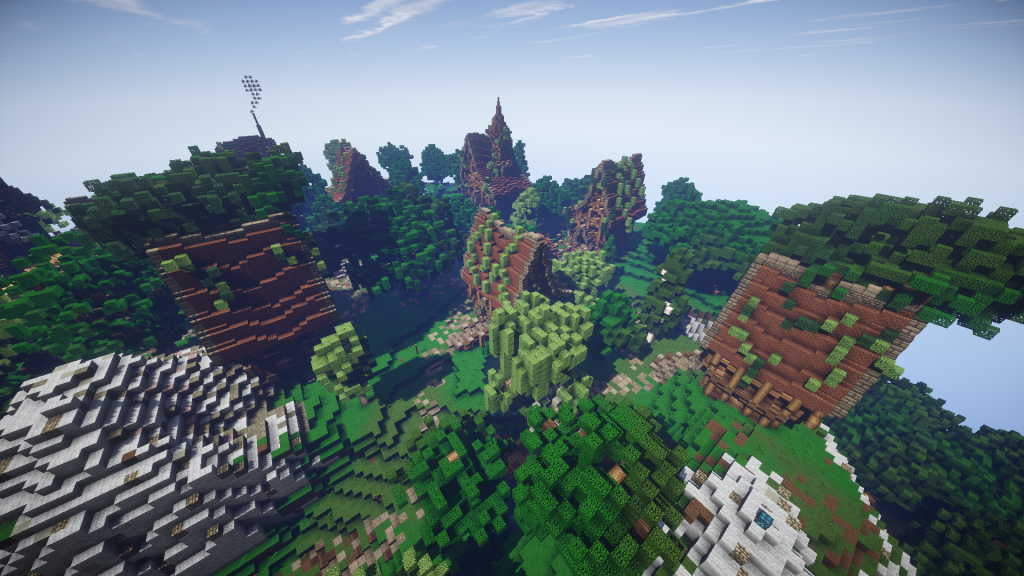
“Elf”, a popular Hunger Game arena, only gives the illusion of allowing emergent play.
Large servers are mostly immune. They have been dealing with my kind for far too long and have put up multiple countermeasures to avoid such shenanigans. Buckets are eerily absent, crafting is not allowed, blocks can be broken but reappear instantly, team-creation with PvP-disabling is not enabled, water is never deeper than two blocks, arenas are small, traps cannot be made, rules are extensive and clear, and final players are teleported into an even smaller arena for a quick final fight. I still managed to get banned by constantly running away from combat, even in the final arena, and by trying to make excessively large teams, but even that was difficult. It bothered me immensely that hunger had almost nothing to do with these Hunger Games, and were mostly ad hoc PvP arenas with often solely superficial themes shared with the moniker. As hard as I tried, I could not roleplay my beloved Peeta Mellark.
Not that they are entirely immune to other kinds of cheating. A cursory search of the most popular Hunger Game MC arenas yield a plethora of detailed maps and paths to obtain the most chests as quickly as possible along with strategies required to win. To me, this is simply anathema to what I thought Hunger Games and Minecraft as a whole represent; emergent play and the ability to improvise strange stratagems in order to win. Instead, I headed to the “small” servers, often exclusively dedicated to HG Minecraft, where my itch could perhaps finally be scratched.
I was surprised to discover that many of these smaller servers had been set up in order to combat this cookie-cutter fast food Hunger Games, and it was glorious. Mobs, traps, temples, elongated gameplay, artificially reduced availability of food, dangerous terrain, spectators or hosts as sponsors, and the ability to hide. It was far closer to what I initially expected after reading and watching the Hunger Game books and movies, and as a bonus, what had been considered “cheating”, making teams and hiding, due to breaking implicit rules on the larger servers was simply my style of gameplay in these servers. I could be Peeta Mellark in all his muddy glory, I was happy, and I wasn’t even cheating.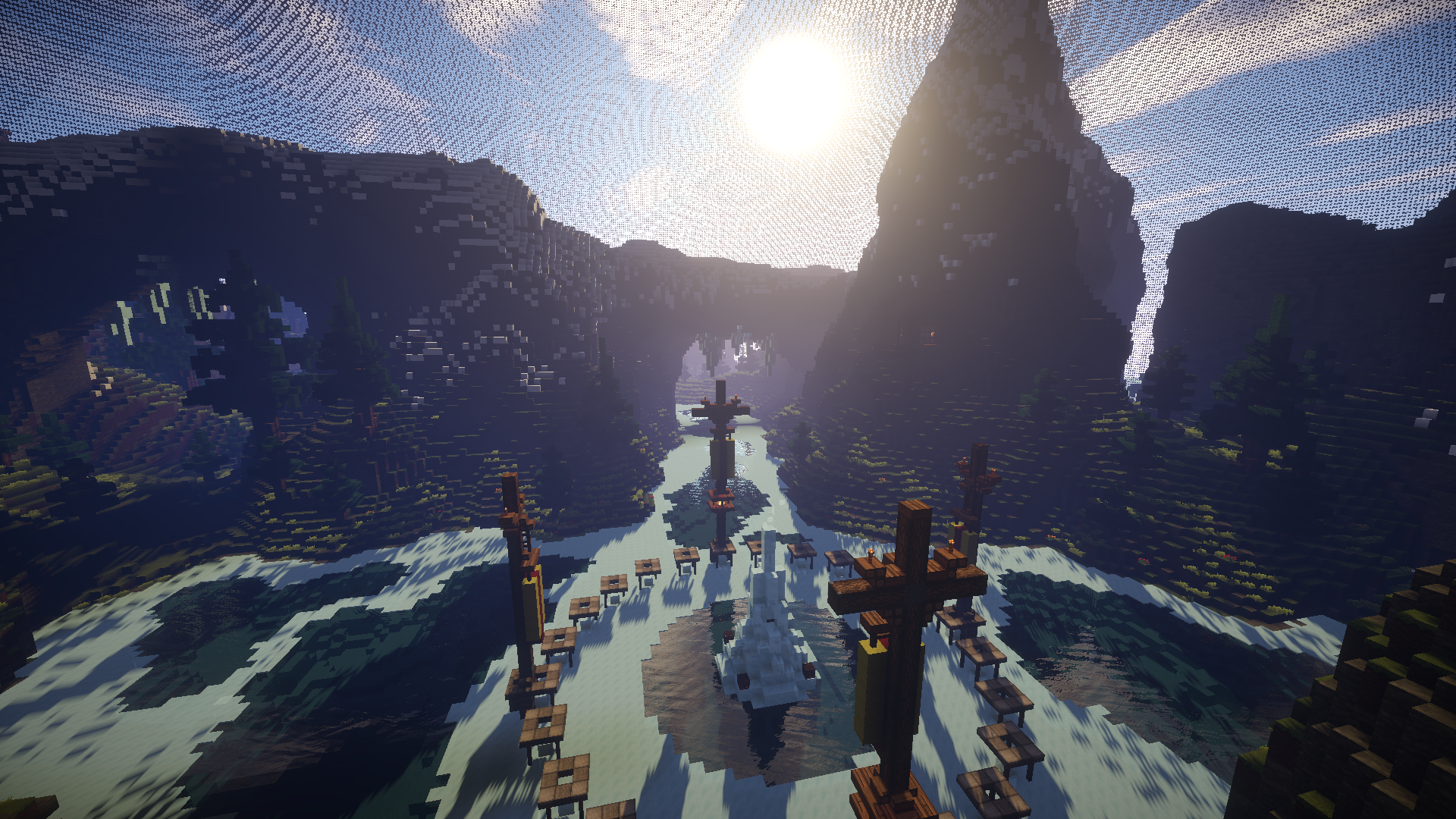
The post Spoilsports, cheats, and other undesirables. appeared first on &.
]]>The post When Arenas Attack appeared first on &.
]]>This week, I tried playing on a different server from my usual – you know, keeping things fresh, and all. My normal server plays like a pretty typical Hunger Games server; there’s a cornucopia, limited items, and implied instructions that you’re just supposed to kill everyone else who’s there.
This new server had all of the above, with a few added features. First, there’s a longer period of invincibility. Most Hunger Games servers give you a bit of this; it gives players a chance to go to the cornucopia and grab as much stuff as they can without being immediately killed. Yes, this is unlike the books or the movies, where the cornucopia is just a bloodbath from the start. On my usual server, however, the invincibility does not last for an incredibly long time. If you stop and camp near the middle of the playing field, other players will come, find you, and engage you in combat almost immediately.
On this new server, on the other hand, there was more time given – over 100 seconds. This doesn’t seem like long, but in Hunger Games time, this is an eternity. I wasn’t too sure why, at first – I grabbed what stuff I could from the chests in the middle, and started walking away, a bit more leisurely than usual. Nobody even tried engaging other people – it was just a mad dash for stuff before running away in different directions. I had so much time to get away and find a hiding spot, so it wasn’t a big deal if I wasn’t super prepared. Honestly, I was carrying almost nothing:
And then it started to get dark. Really dark.
This is where this server differs from other servers I’ve played on: almost as soon as the game starts, it gets dark. Dark, in the Minecraft world, means that monsters will appear. And while this is okay for a bit, due to the extended invincibility of this game, it very quickly turns into not okay. Monsters were everywhere, and with such limited supplies, I found it very difficult to survive. I really felt as if the arena was out to get me almost as soon as the game had started. There were a few chests around, but they were few and far between, and none contained anything I could really use to protect myself. So I ran.
This is different than most of the other servers I’ve played on, and it ties in with some of the ideas that we were throwing around at our last meeting. What would happen if the arena was more hostile towards the player? Would players react differently towards both the environment and to the other players? Certainly, it made it more difficult, and seemed to be a bit more true to the books in the sense that the game (pretend it’s the gamemaker from the book series) throws unexpected elements at you that ultimately steers you towards other players (and your death).
Sticking with my theme from last week, though, I noticed an emergent behaviour in many of the players: teamwork. Players were banding together to fight off the monsters, even though they didn’t establish teams/alliances at the beginning of the game like many try to do. It seemed like something that happened more out of necessity. Truthfully, it’s a lot more satisfying to win by killing your opponents rather than just have them all die off because they can’t defend themselves against the elements. Perhaps that’s what players were doing.
I didn’t make it to morning, so I don’t know from my own experience. Would players have helped me fight off zombies, or just let them kill me? Would they kill me themselves and then run away from the horde? I’ll play around on this server more and see if this is a common occurrence!
The post When Arenas Attack appeared first on &.
]]>